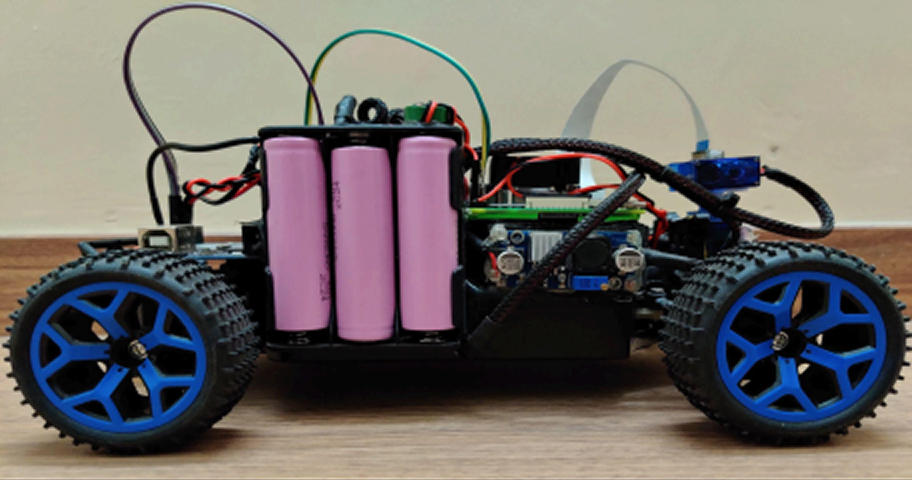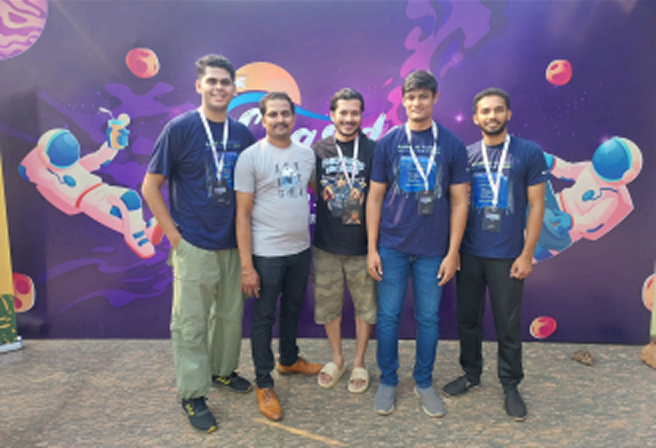Overview
An exclusive interview with cybersecurity expert Seedon Adlin D'Souza about his unconventional path from Mechatronics engineering to becoming a recognized security professional.
Meet Seedon Adlin D'Souza - a cybersecurity professional whose unconventional path from Mechatronics engineering at Manipal University to becoming a recognized security expert and Black Hat conference speaker offers valuable insights for aspiring cybersecurity professionals. Known for his innovative "Kali on Wheels" project, his ham radio callsign VU2MHC, and his significant contributions to the security community, Seedon's story demonstrates how curiosity and persistence can trump formal credentials in building a successful cybersecurity career. In this interview, Seedon shares his journey, insights, and practical advice for students looking to break into cybersecurity.
The Early Spark: When Curiosity Met Opportunity
"I got into cybersecurity way before my college days. I was interested and already exploring right when I was in 10th grade, but back then it was quite difficult to get hold of a computer”, Seedon recalls.
Unlike many professionals who discovered cybersecurity through formal education, Seedon's journey began with pure curiosity in high school. "I somehow managed to learn programming way before my college days. I started with C and was also into electronics and embedded technology", he explains.
His choice of Mechatronics at Manipal wasn't random: "I picked it because it had 'a bit of everything' like electronics, mechanical, software and I liked that cross-domain exposure." This multidisciplinary foundation would later prove invaluable in cybersecurity, where understanding systems holistically often matters more than deep specialization.
From Theory to Reality: The First Real Job
When asked about his transition to professional work, Seedon is candid about the reality: "Academic learning gave me the theory, but real-world systems are a different beast – they're patched, misconfigured, and built on countless assumptions. The transition felt natural because I'd already been tinkering on my own, and honestly, my personal projects prepared me more than coursework ever did."
Starting as a cybersecurity trainer, Seedon's career quickly evolved: "I was initially hired as a cybersecurity trainer, but I quickly got pulled into much more. Soon, I was traveling across India for pentests in all sorts of sectors, from petrochemical factories to banks, and even on a ship. That hands-on exposure shaped me far more than any classroom could."
Building Community in the Early Days
Finding like-minded individuals wasn't easy when cybersecurity wasn't yet mainstream. "Back then, 'cybersecurity' wasn't cool yet," Seedon remembers. "I gravitated toward a few people who liked hacking things – not just computers, but drones, electronics, whatever."
His involvement with ham radio was significant: "I also got involved in Manipal Ham club (VU2MHC) & I also got my Ham exam cleared in 2012." The technical community extended beyond campus: "My network grew outside Manipal, too, through forums, IRC, and eventually conferences at NITK Surathal shaped me as I used to attend them every year for the infosec crowd."
Seedon also mentions the early days of Indian cybersecurity: "I did know about c0c0n in its infancy and I used to use Matriux OS but I never could afford to travel to the conferences."
When asked about formal cybersecurity communities at Manipal, Seedon reflects: "I wasn't part of a formal club. Looking back, it would've helped – finding your tribe early saves time because you share tools, ideas, and failures. Cybersecurity is too big to go solo forever. Most of my friends and resources were on IRC, pastebin and forums. There was knowledge everywhere and malware too."
Innovation Through Necessity: "Kali on Wheels"
One of Seedon's most notable early projects was "Kali on Wheels." He explains the motivation: "That was me turning curiosity into practicality. The idea was simple: why be stuck with a laptop when you can make a portable hacking rig? I wanted something self-contained for on-site testing and learning. 'Kali on Wheels' was about freedom – to carry your lab in your backpack and hack anywhere."

From Tool User to Tool Creator
The evolution from using existing security tools to creating custom solutions came naturally for Seedon: "At some point, you realize off-the-shelf tools only get you so far. I hit limitations and started coding to automate repetitive stuff or to exploit gaps existing tools didn't cover. The biggest hurdle wasn't technical – it was mental, overcoming the 'why reinvent the wheel' voice and trusting that my wheel could spin differently."
The Path to Recognition
When asked about speaking at major conferences like Black Hat, Seedon's response is humble: "I didn't plan it. I just kept working on things I thought were cool and useful, and when the work got noticed I started applying for CFP (call for papers). The leap came from building credibility through contributing selflessly to the community and being willing to share openly even if the work wasn't 'perfect."
The Power of Community: Seasides and Beyond
Reflecting on community events, Seedon is particularly enthusiastic about Seasides: "Events like Seasides are where you realize cybersecurity is more than just exploits – it's people. You meet hobbyists, researchers, and veterans all in one room. The community is where collaborations are born. Seasides especially feels raw and authentic. Seasides has given me everything!"
Competitive Hacking and CTFs
Seedon's first CTF experience was memorable: "Chaotic and humbling. You think you're good until the timer starts, and suddenly you're staring at problems you've never seen. CTFs taught me resourcefulness Googling smart, working under pressure, and not being afraid to fail fast. The first CTF I played was a Hardware CTF at Nullcon 2020. It was an in-person CTF, I came fourth."
Roadmap for Aspiring Security Professionals
Foundation First
When asked about advice for students, Seedon emphasizes fundamentals: "I'd say start with development basics. If you don't know how systems are built, you won't know how to break them. Then dive into cybersecurity."
For penetration testing specifically, his advice is encouraging: "As cybersecurity is a big industry there are roles for everyone, but if you ask me how to be a Penetration tester then I would say the only skill you honestly need is the drive or curiosity, rest everything can be learnt."
Essential Skills Development
Seedon is clear about the importance of coding: "I know how important coding is if you have to do any meaningful work. Well pentesting can be performed with or without coding knowledge but the output will be very different."
Reflecting on what he'd do differently, Seedon says: "Start earlier. Don't wait for a job title to hack. If I were starting today, I'd spend more time on foundational coding skills before diving into exploits – it would've saved me time later."
Building Your Portfolio
When asked about portfolio projects, Seedon provides specific examples:
- "Automating small tasks (log parsing, recon)"
- "Building simple exploits or fuzzers"
- "Creating writeups/blogs of solved problems"
- "Contributing to open-source tools"
- "A project that solves your own problem is always portfolio gold"
He adds: "Anything you can think of actually, in fact if you can code or even vibe code then you will be able to build tools right away that will help you do what you are learning at that moment, as there are so many activities in pentesting there are gaps that can be filled by automation."
The Reality Behind the Glamour
What They Don't Tell You
Seedon is honest about the challenges: "Burnout and politics. You spend as much time explaining security to non-technical people as you do finding vulnerabilities. And sometimes, the bigger fight is convincing people to fix what you already proved is broken."
Landing Your First Job
His advice for job seekers is practical: "They want proof you can learn fast and solve problems, not just list tools. A strong portfolio, GitHub repos, and writeups speak louder than 'I know Wireshark."
The Importance of Networking
"Networking is underrated. It's how opportunities find you before job portals do," Seedon emphasizes. "My advice: contribute, don't just consume. Share writeups, ask genuine questions, help peers. That's how connections stick."
Evolution of Perspective
Working in cybersecurity companies shifted Seedon's understanding significantly: "Before, I thought cybersecurity was all about exploits and firewalls. After working in the industry, I see it's equally about compliance, business risk, and long-term resilience. The most secure system isn't the one with zero vulnerabilities – it's the one with processes that can adapt when vulnerabilities inevitably show up."
Key Lessons for Today's Students
Start Early, Start Now
Seedon's advice is clear: "Start earlier. Don't wait for a job title to hack."
Curiosity Over Credentials
The most important lesson from his journey: "Curiosity beats credentials. The degree gets you in the room, but curiosity and persistence keep you relevant."
For learning resources, Seedon maintains a comprehensive repository: "I get asked this question way too often, I have a repo just for this you will get everything on my Github @seedon198."
Conclusion
Seedon Adlin D'Souza's journey from a curious 10th grader learning C programming to a recognized cybersecurity expert speaking at Black Hat conferences illustrates several key principles:
- Cross-disciplinary knowledge provides unique advantages
- Hands-on experience trumps theoretical knowledge
- Community contribution builds lasting professional relationships
- Continuous learning and adaptation are essential for long-term success
- Curiosity and drive matter more than formal credentials
For students embarking on their cybersecurity journey, Seedon's message is clear: start with curiosity, build foundational skills, contribute to the community, and don't wait for permission to begin hacking and learning.
As Seedon puts it: "Anything you can think of actually, in fact if you can code or even vibe code then you will be able to build tools right away that will help you do what you are learning at that moment."
His journey from VU2MHC ham radio operator to Black Hat speaker proves that with curiosity, persistence, and community involvement, unconventional paths can lead to extraordinary careers in cybersecurity.

Connect with Seedon Adlin D'Souza
LinkedIn: linkedin.com/in/seedon
GitHub: github.com/seedon198 (Comprehensive cybersecurity learning resources)
Websites:
Follow Seedon's continued contributions to the cybersecurity community and access his extensive repository of learning resources for aspiring security professionals.


